
End of Summer 2023 Miramichi Salmon Blog
Fishing Friends:
Summer is getting a little long in the tooth. This past Wednesday morning we were forecast to see scattered frosts around New Brunswick. That was common 20 years ago, and frankly it feels right to me now. Not that August has
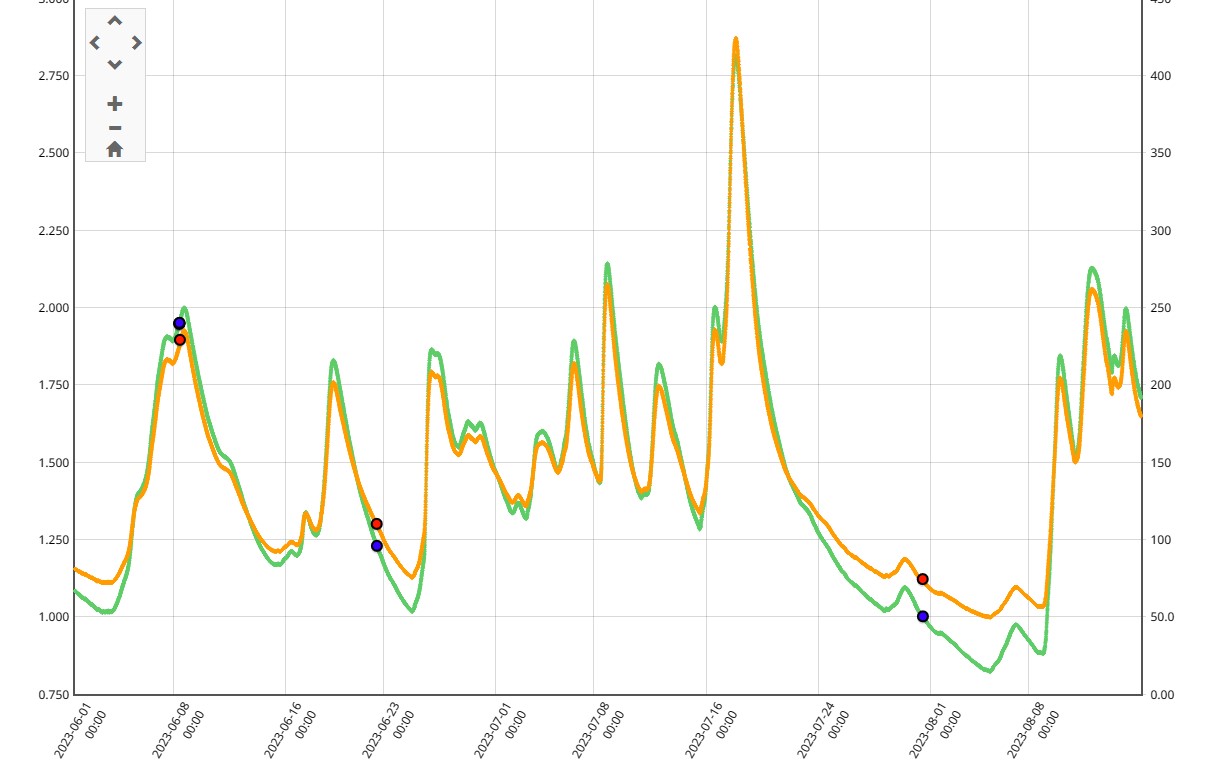
Water height in meters on the vertical axis and dates on the horizontal. Only a brief window of sub-one meter water heights this summer, and that’s when trap numbers bumped up.
been all that warm a month this year anyway. Thanks to MSA life-member Albert Putnam, I’ve now learned that water temperatures are now again available on the Blackville gauge. Scroll down to Controls and with the drop-down arrow change Water Level to Temperature. Temps barely reached 21C/70F the first couple days of the month but haven’t been near that warm since.
The big story of this summer, though, continues to be high water. The present height is 1.0M in Blackville, and it is on the way down – at least for right now. Normal heights for late August are more like .65M, so we are still about a foot above normal. The water did get down to .8M during the first 10 days of the month – still higher than normal, but reasonable – and during that time we registered our best two-week trap catches of the summer – and the first two weeks of August are not known for big runs. The question is whether the runs were improved over earlier in the summer or was it just that because of the lower water level the traps were catching a lot more efficiently. Let’s tackle that issue.
Relative to other recent years both the Millerton and the Cassilis counting traps registered their best two-week period of the summer ending 8/15. The total captures for the year to date are very bad indeed, but these last two weeks are well within the range of the last few years. The question is just how accurate a representation of the run are these counts?
Looking at some historical data the Millerton trap captured 45 salmon – not grilse – between July 31 and August 15, 2021, then only 13 during the same period in 2022. In 2023 34 were counted. The 8/15 year-to-date trap captures for 2021, 2022 and 2023 respectively were 254, 251 but only 94 this year. The 34 that entered during the first two weeks of August this year amounted to 56% of the 60 salmon that had been captured during all of June and July. In 2021 that same percentage was 21.5% and in 2022 it was just 5%.
The NW branch 7/31 to 8/15 trap catches were even more out of whack. In 2021 19 salmon were trapped during that period, in 2022 it dropped to only 3, but in 2023 it was 36. As of 7/31 the NWM trap had captured 113 in 2021, 109 in 2022 but just 23 in 2023! It just does not seem possible that the run from 7/31 to 8/15 was 150% of the run from June 1 to August 15. In summary it sounds highly unlikely to me that the run of salmon into the Miramichi so far in 2023 is accurately portrayed by the poor catches in the traps. While the overall trap numbers so far suggest a much weaker run than in either 2021 or 2022 it appears that this year’s run is more similar to other recent years than the trap catches suggest.
I spoke to two prominent Miramichi salmon biologists before writing this, and both reiterated that it is understood that the traps are less efficient in high water than low. Beyond the height of the water, though, other things can come in to play. Have the nets been fishing constantly or has the high water caused down periods where the nets were lifted up or removed? Have the DFO workers been able to keep the traps clean of debris? Debris can apparently clog the traps up enough that they no longer fish effectively. DFO does not talk openly about these things, so it is hard to answer these questions.
We still have two months of trap counts to go, and we’ll have to analyze those numbers before we can say much about the year as a whole. You can look at the trap counts yourself on the DFO website at this link. It takes a little while to learn your way around this page, so don’t hesitate to e-mail me if I can help you.
The relatively few fishing reports that I’ve been able to gather from the Miramichi are actually pretty good, and that has been the case most of the time throughout the summer. Mid-August is not the most popular time for salmon fishing on the Miramichi, and that is because conditions are often
not that good. Even some of the outfitters are now on summer vacation. People are saving their time for the fall season. At this time in late summer salmon are often “pooled-up” in warmish low water where anglers are working constantly over a bunch of fish that are mostly reluctant to take a fly. This year, the cool, elevated flow of water has the fish spread out and often on the move. An e-mail yesterday from Eddie Colford at Black Brook said that they had just landed a 16-pound hen salmon with sea lice. That’s a great fish. Meanwhile guide and casting instructor Steve Smith fished two of the more productive Cains River pools and never had a touch. That, as they say, is fishing, but he did see a fisher cat, which is a real bonus. My neighbor Donnie Keenan’s wife Kathy sent me a photo of Donnie with a nice salmon caught in high water at Charlie’s Point where he and his brother Johnnie have been landing Miramichi salmon for nearly 70 years – I’ve been watching them do it for the last 21. The fish appeared very fresh for an August fish.
I’m often asked what weight of Spey rod I like for the Miramichi. Actually, I have settled on one rod that I fish on both the Southwest and on the Cains. I used to bring up both a 15’ 10-weight and 14’ 8-weight. I find, though that I’m just not using that larger rod. I like the 10-weight in Scotland where due to the cold water we fish a lot of sink tips and metal tubes in the early fishing. By the time we start fishing the Miramichi in June the water is approaching 60F and metal tubes are illegal on the Miramichi anyway. Since we are using mostly full floating setups, I find that an 8-weight is powerful enough for even the SW Miramichi, and on the Cains, it is light and delicate enough to fit in quite well also. This fall I’m going to fish a lot more with a sinking poly leader, but I won’t be dredging up any heavy flies.
For the last few seasons, I’ve been using a 14’ 8-weight, X-Spey for my wet fly fishing. I still prefer a single hand rod for dry flies. I’ve got a new Sage 13’6” Igniter to try for this fall. I’ve been using a 9-weight single hand Igniter in the salt for a few seasons, and it is an incredible canon – very thin and ultra-fast. I’ll give a full report on this in my end of season blog in late October.
I’ve had some interesting correspondence recently with John Bagnall a fishery scientist and member of
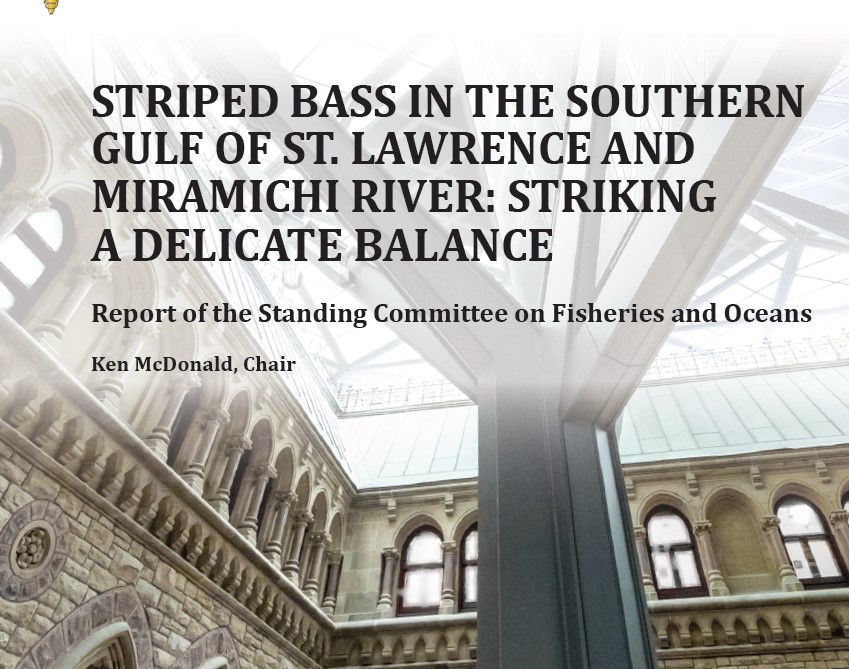
This government committee told DFO to bring the striped bass and Atlantic salmon populations in the Miramichi into balance.
the New Brunswick Salmon Council. Like most fishery scientists I know John feels that the biggest issue currently facing the Miramichi’s salmon is the ridiculous over-population of striped bass. John shared a lot of information with me regarding the bass situation and one document that I was not familiar with was a 2019 report from the Canadian House of Commons Standing Committee on Fisheries and Oceans. In this report the committee detailed 5 recommendations for the Miramichi striped bass fishery. One of these was that DFO should “prioritize” a balance between the striped bass population and the Atlantic salmon in the Miramichi. Instead, since 2019 the striped bass population has continued to expand to the detriment of all other resident species in the Miramichi, and if anything, DFO has just dug in its heels against any requests – including from the governmental body that oversees them – to change that course. John showed me a letter he had written to DFO on behalf of the Council asking for the adult spawning bass population to be reduced to 100,000, a number that he feels would allow for a strong salmon population, and that would still allow for an excellent striped bass fishery around the Gulf of Saint Lawrence.
As further evidence of the wisdom behind the 100,000 number he provided these quotes from DFO scientist emeritus Gerald Chaput.
Chaput, G. 2022. Multi-species Considerations for Defining Fisheries Reference Points for Striped Bass (Morone saxatilis) from the Southern Gulf of St. Lawrence. DFO Can. Sci. Advis. Sec. Res. Doc. 2022/030. vii + 50 p.
- Chaput. “There is direct evidence of predation by Striped Bass on Atlantic Salmon smolts, and several studies using acoustic tag technologies have inferred predation events and changes in estimated survival rates in the early phase of migration through Miramichi Bay that point to Striped Bass predation as a likely driver of these variations in estimated survival rates. Based on acoustic tagging estimates of survivals through Miramichi Bay, the years when Striped Bass spawner abundances exceeded approximately 100 thousand spawners corresponded to year with visibly lower estimated survival rates.” and:
“Striped Bass abundances in the range of 100 thousand spawners in the past corresponded to high landings of gaspereau and smelt, and the highest survival rates of acoustically tagged smolts through Miramichi Bay.”
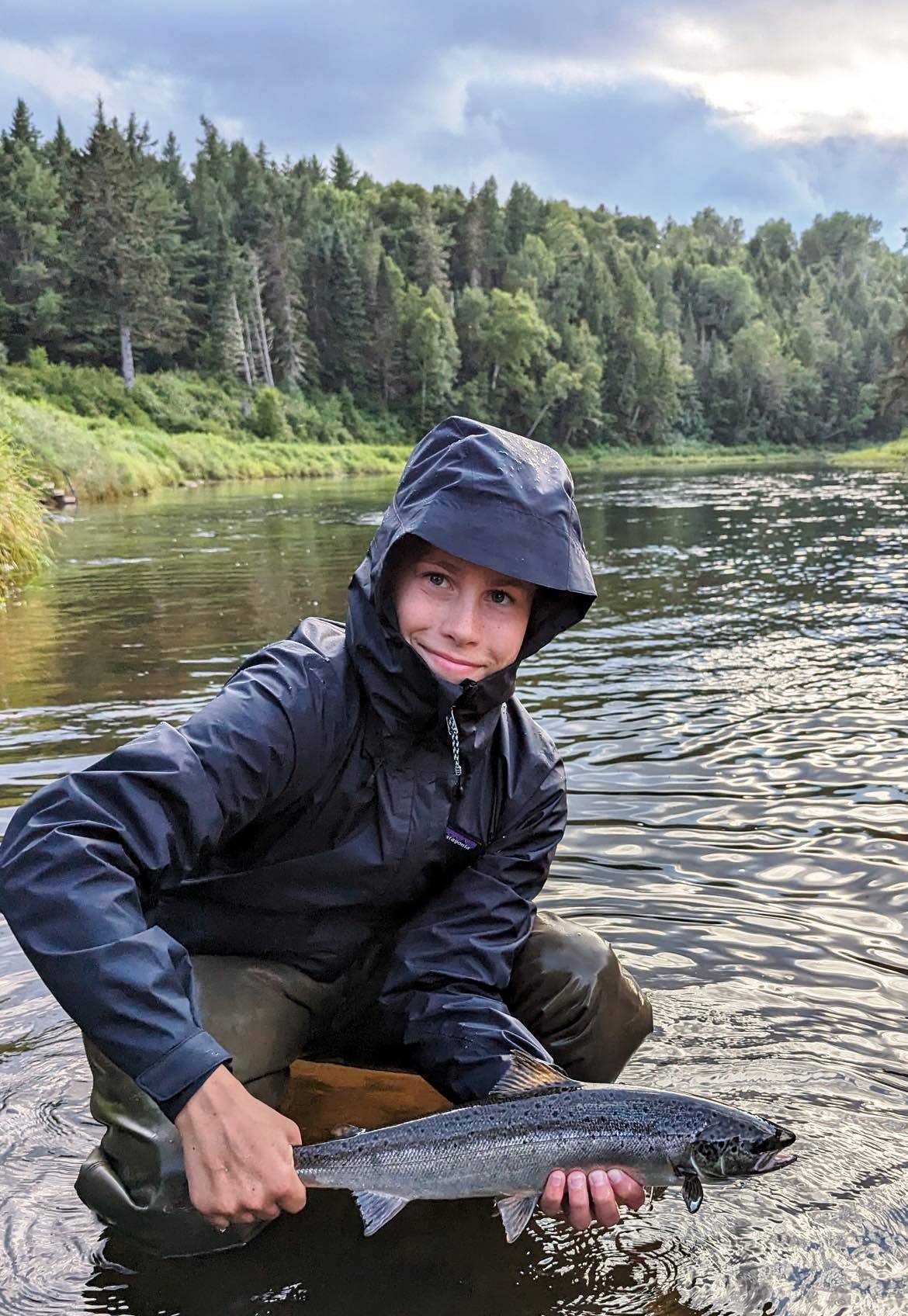
Its grilse like this caught by Sami Duis from Germany that are in especially short supply due to the out-of-balance striped bass population.
Some of you may remember that I came up with the 100K number myself in early August. I’m not a fishery scientist, but according to page 3 of the DFO’s recent publication Update of Spawner Abundance and Biological Characteristics of Striped Bass In The Southern Gulf of St. Lawrence To 2022 the Miramichi hit this 100K striped bass figure sometime around 2008/2009, and not long after that is when we started to see big reductions in the grilse numbers followed by salmon.
Somehow or another we have to get this striped bass population target adopted by the Moncton office of the DFO. I can tell you that the urgent need to bring the striped bass population into harmony with good Atlantic salmon runs is not lost on my fellow board members of the MSA, and together with allied organizations we are working diligently in that direction.
This year we’ve also been reporting on the salmon fishing in the Northern Highlands of Scotland. I scanned through Geordie Douall’s weekly report from the River Thurso – which empties into the east side of the north coast of Scotland – and saw that a couple of my March fishing mates from the Naver were listed with their catches. The numbers were very modest compared to their normal August catches. These northern rivers don’t have really large autumn runs, and August finds a large percentage of the season’s fish already in the rivers. Given a little touch of rain it can be gangbusters, but conditions have not been great. Even though the reports are that there are good numbers of fish in the Thurso, the 2023 catch to date is about 50% of the 10-year average and 60% of the 5-year average.
On the Helmsdale River which flows into the northern east coast of Scotland ghillie John Young had this report: “Up in the Helmsdale it has been pretty slow due to lack of water. We had a lift 5 weeks ago and had a good week with 34 fish for two rods. I think the river had around 110 for the week , not as many grilse about this year and leaning to the smaller size around 3lb mark , the hitch and normal summer tactics have not been doing too well for some reason , probably down to a smaller run this year and the pools not as full as normal , at the moment the fish have switched off and we are getting one a day , no pinkies that I’ve heard of in Scotland, but quite a lot appearing in Scandinavia. There are a lot of seatrout being reported around Scotland right now. Although Scotland has been fairly quiet through the summer, the rivers are picking up over the last few weeks, with the Tweed and Tay both doing quite well with some good-sized summer fish (15 lb to 25lb).”
Fall fishing is just around the corner. Every year at Campbell’s Pool we donate Labor Day fishing trips to the MSA and the Atlantic Salmon Museum, so those parties will be coming in over the next 10 days. I’m headed up on September 7th to fish for the rest of the season. Honestly, I can’t decide whether I prefer fall or early summer fishing. Historically the catches have been more consistent in the fall, and even in 2022 that was true for us. In any case I’m really looking forward to autumn days on the Miramichi. I use my cell phone as my computer while I’m in camp, and I just can’t put together a blog like this with it. I can, though, write a daily fishing report, and I can post photographs. So, starting on 9/8 I will be making daily entries that you can read at this link. Please save the link and check in daily to see what is happening with the Miramichi and Cains River fall salmon run. If you’re fishing the Miramichi yourself don’t hesitate to send me your observations at bigbass@maine.rr.com.
Thanks for reading. Brad Burns
PS: To receive notices of new Miramichi Salmon Blogs sign up here at no charge.


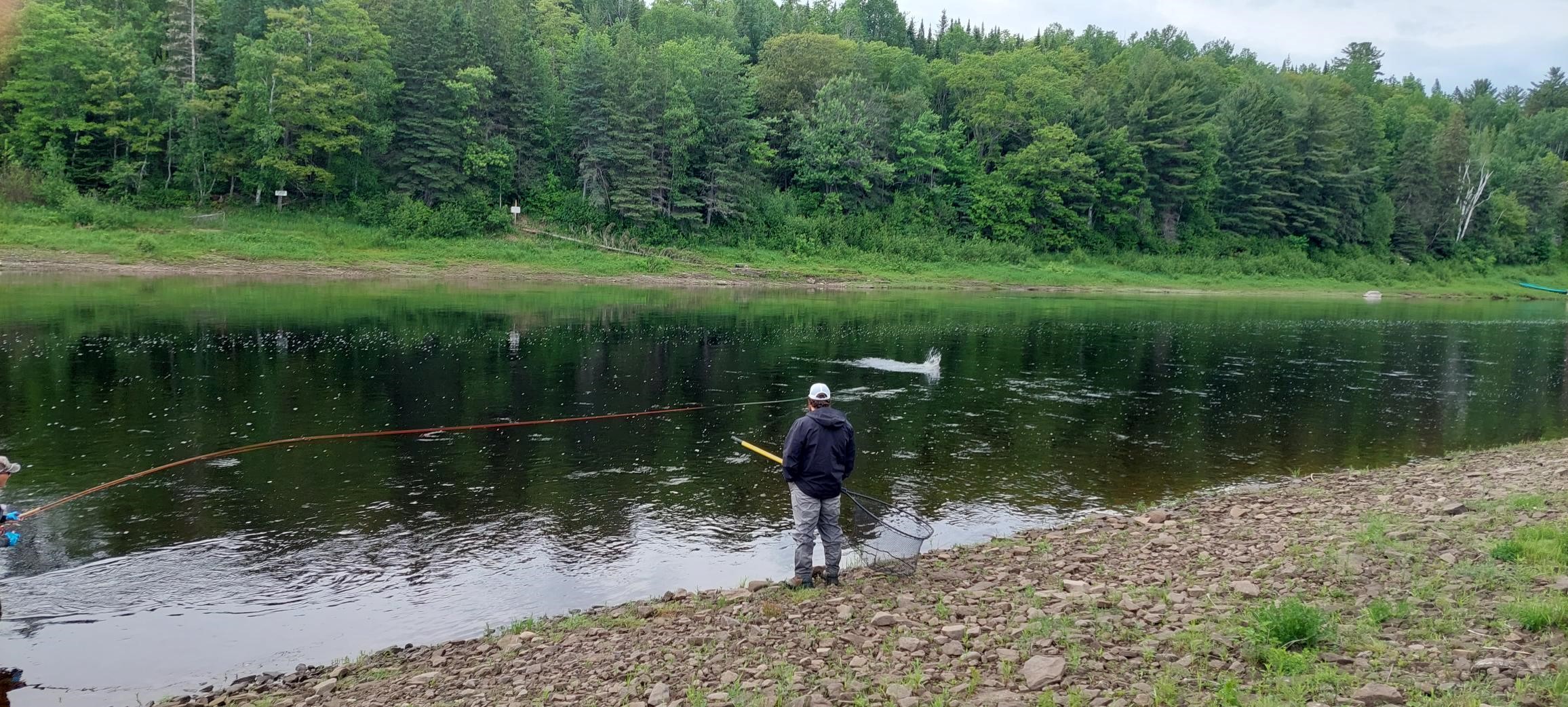
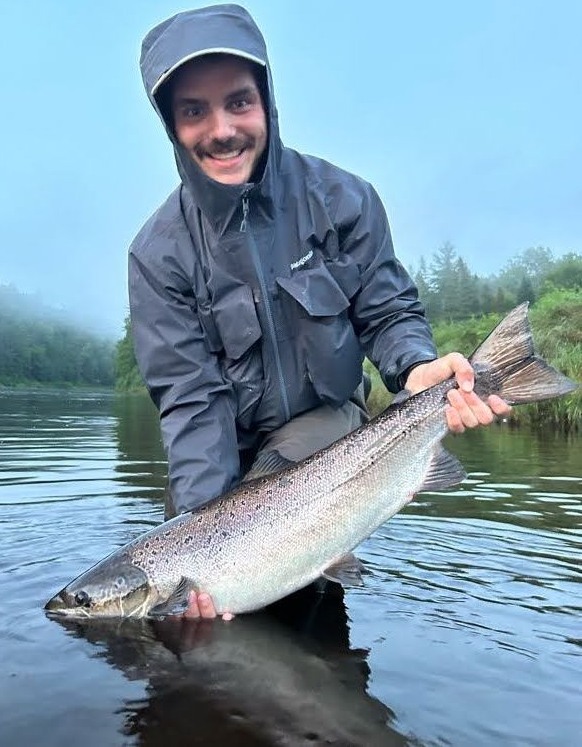
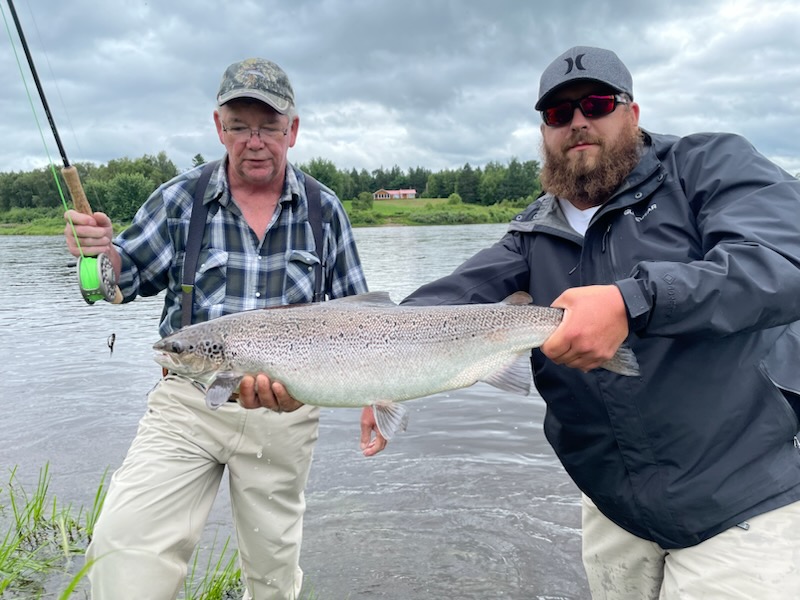
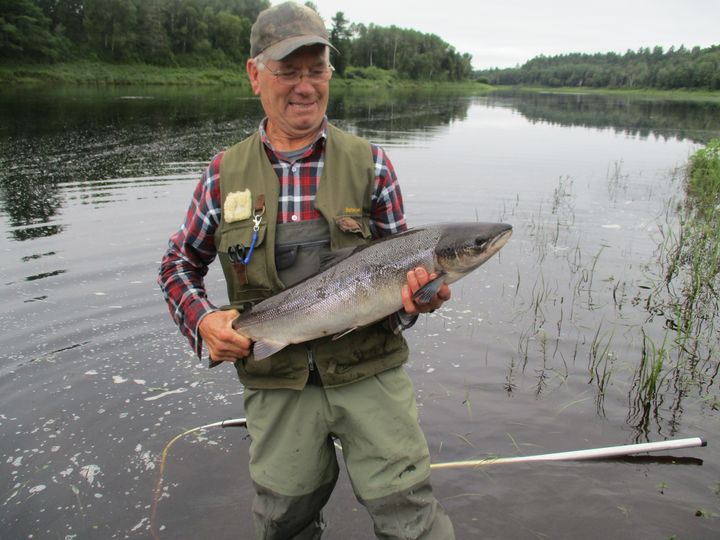
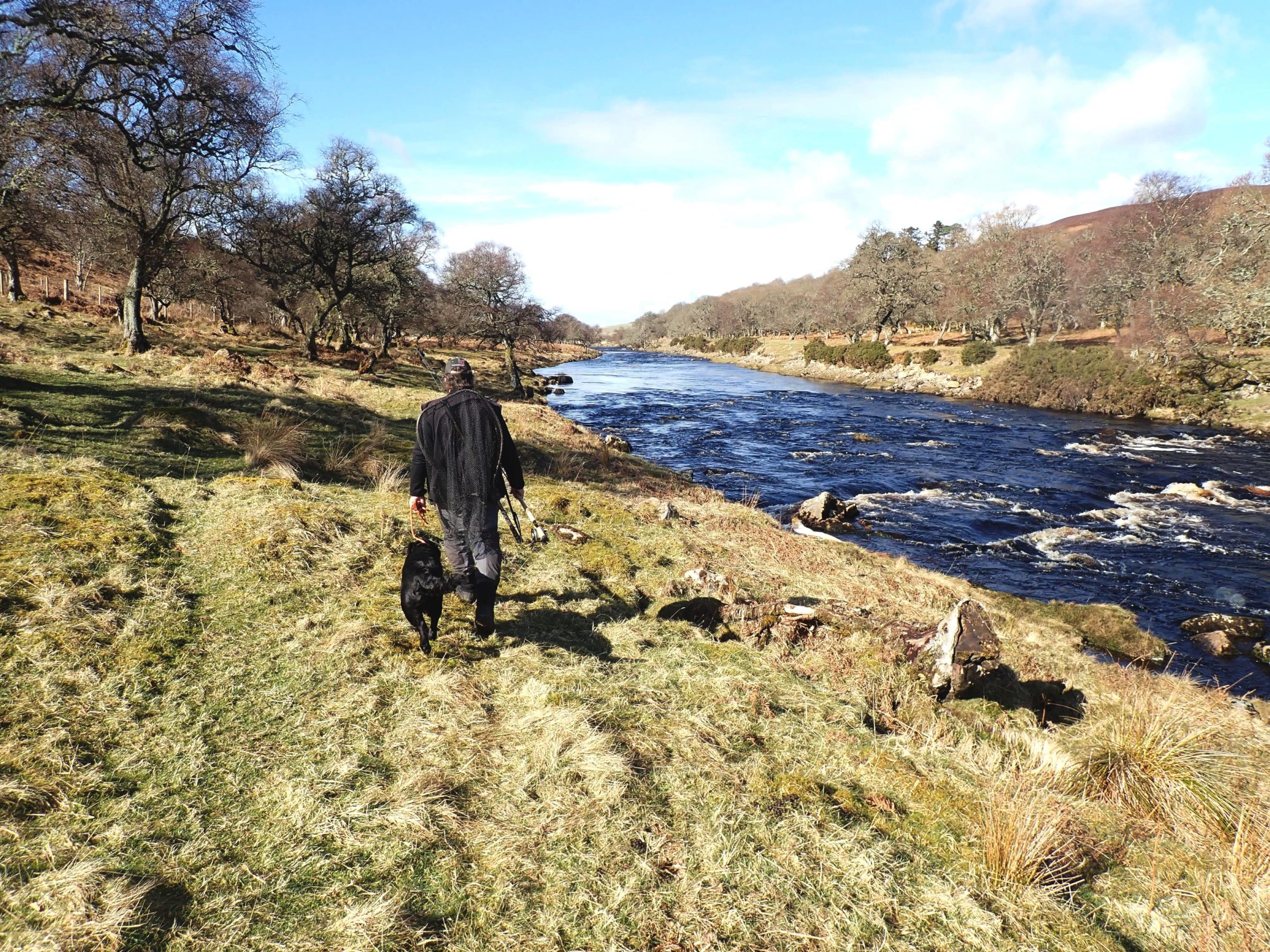
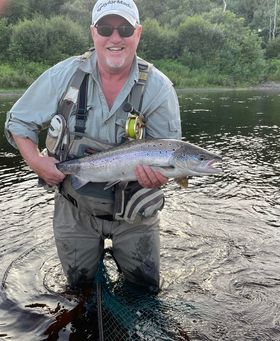
Hi Brad,
I love your blogs. Keep up the good work.
But I am very disappointed by the continued intransigence of NB DFO regarding the imbalance of Miramichi system striped bass and salmon. Are the NB voters more happy catching bass than salmon these days? Even if they are, they should understand (or be educated) that the bass population will ultimately crash after overpredation takes place. Lose lose. Better to allow more bass being harvested now (that should please the voters) than wait for the ultimate collapse. How do we shame DFO publicly that they are mismanaging the system?Do they ever have public forums where they have to defend and validate their bass/salmon management practices? Do they have long term projections of the relative populations of the two species? Since our pleas for a change in policy have been ineffective to date, what else can be done?
I’m not sure that until very recently that DFO has understood just how direct an effect the huge striped bass population has on the Miramichi’s Atlantic salmon. No stone will be left unturned on attempts by the salmon community to get this situation changed. Alternatives will certainly include greatly stepped-up lobbying efforts and stronger scientific arguments. As a last resort legal action will definitely be considered.
Thanks, Brad. Another terrific report and a gift for us who can’t be around the river on a regular basis.
Thanks Joe. I hope to run into you this fall.
Hi Brad, thanks for the report and essay. A great read, as usual. I hope you find some fish this fall!
FWIW – I settled on that 13’6″ 8-weight IGNITER as my rod of choice on the Miramichi though I also found a 12′ 8-weight X to be a nice tool in the bag for some of the pools on the Cains. I like a 510 grain Scandi Short on both.
Cheers!
For those not familiar Jesse was the northeast rep for FarBank which owns Sage and Rio, and he is a professional level Spey caster. Jesse’s advice is worth listening to.
I am a little surprised to hear you favor the short scandi? Is that just for the ease of casting?
Hi Brad, the short answer to your question is Yes, for ease of casting.
But to go into the weeds a little bit, I’ll add that I also like the 520 grain RIO Scandi on the 8136 IGNITER, which is four feet longer, at 38′. When I was on the Miramichi this past July, I arrived with the 520 grain head on my reel but quickly found myself challenged due to the higher water – deeper wades and less room behind me for D-loops. So, the 34′ 510 grain casted and fished a lot better for me. Were I fishing shin-deep with nothing behind me, I think I would’ve preferred the longer head.
I’ll also add that I fish different length leaders on those two rods; something close to rod length. I really like those WW Doak’s hand-tied leaders!
I see that RIO just released a new family of Scandi heads. I haven’t cast these yet but it looks like there are two heads in question here: 500 grains at 36′ and 520 grains at 37′. Always more “riggin’ and friggin'” to be done, eh? Cheers!
Just saw that myself. I’ve already got two head cases of those things… I have an older 550 grain Steelhead Scandi line that I actually like on my 8-weight X-Spey better than I do the 520. I find that the Scandi turns over poly leaders more consistently than it does long mono leaders. I’ve preferred mono leaders unless the water is really cold, but I saw the intermediate poly leaders make quite a difference this year in Nwfld. I’ll try the 520 and see if that turns the mono over more easily. I too like those long, knotted Maxima leaders.
Brad – I am also surprised Jesse favors the short scandi, but then that time I was up at Campbell’s and you and I watched Jesse casting, I noticed he (like each of us) has his own unique casting style.
Absolutely love reading your blog and seeing pictures of familiar fishing spots.
Would it be possible to darken your font as the gray is a bit difficult to read.
Kathleen – I’m away from my PC but will check this out. Honestly I thought it was black. Brad
Hi Brad,
Fantastic blog entry (as usual)! I always look forward to your reports.
Like you, I favor a 14-foot rod on the mainstem Miramichi. I use a Gaelforce Equalizer 14-foot for a #9/10 (a #8/9 in AFFTA ratings) with a Gaelforce ESH Floating Shooting Head #10 at 600 grains and 39 feet. You cast the rod and line when we last fished together. I use a monofilament leader that is at least the length of the rod (longer if the water is low). If I need a little more depth, I use a hand-tied 14- or 15-foot fluorocarbon leader instead of a polyleader. In my experience, a full fluorocarbon leader is stealthier and fishes better than a polyleader when combined with a floating line. If I need more depth than I can achieve with that set-up, I change lines to an Intermediate sinking tip and adjust the leader accordingly.
Best wishes and tight lines this fall.
Topher
We are lucky to have comments on Spey casting techniques from two experts like Jesse Robbins and Topher Browne.
Brad, Jesse and Topher,
Greatly appreciate all of the knowledge sharing on Spey rods, line types, grain weights and poly leaders. Please keep it coming!
I agree with your analysis of this the stripper situation and a way must be found to move the smolt beyond the strippers. I always thought that the grilse should out number the salmon caught by three or four to one especially in July on the MSW. Let us hope the DOF act before it is too late. Keep up the writing and pushing for the salmons survival.
Thanks for your comment Steve. In doing the research for On the Cains I learned that previous to the mid 1960s the catch at Seabury Stanton’s camp on the Cains included more salmon than grilse every year. It changed in the mid 1960s, I presume because of the commencement of the Greenland salmon fishery which targeted the MSW salmon. Still, the recent decline of grilse numbers compared to salmon appears to me to be because of the stripers. The stripers aren’t eating the grilse, but the grilse returns show the effects of the striper predation on smolts more dramatically than the MSW salmon do because they have only one year of ocean survival to buffer the results.
Thank you for the kind words. I agree that it is clear that the smaller number and percentage of grilse is due to smolt predation by striped bass.